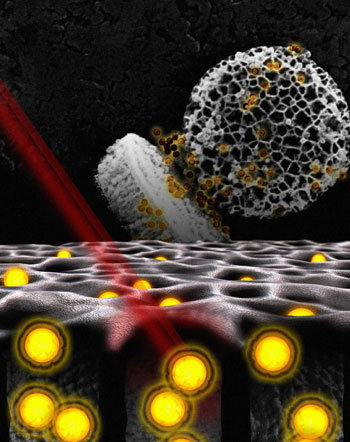ScienceDaily (Jan. 19, 2012) ? A team of researchers at the University of California, Merced, has redesigned luminescent solar concentrators to be more efficient at sending sunlight to solar cells.
The advancement could be an important breakthrough for solar energy harvesting, said UC Merced physics Professor Sayantani Ghosh, who led the project.
"We tweaked the traditional flat design for luminescent solar concentrators and made them into cylinders," Ghosh said. "The results of this architectural redesign surprised us, as it significantly improves their efficiency."
The main problem preventing luminescent concentrators from being used commercially is that they have high rates of self-absorption, Ghosh said, meaning they absorb a significant amount of the light they produce instead of transporting it to the solar cells.
The research team showed the problem can be addressed by changing the shape of the concentrator. They discovered a hollow cylindrical solar concentrator is a better design compared with a flat concentrator or a solid cylinder concentrator. The hollow cylinders absorb more sunlight while having lower self-absorption losses.
Luminiscent solar concentrators are designed to absorb solar radiation over a broad range of colors and re-emit it over a narrower range (for example, only red), a process known as down-converting. This light is transported to solar cells for photocurrent generation. The quantum dots embedded in the concentrator are the materials that carry out this color conversion.
The biggest advantage they offer over traditional solar cells is that they can work even in diffuse sunlight, like on cloudy days. And because of this, they do not need to directly face the sun at all times, eliminating the need for tracking mechanisms.
Ghosh said the discovery could make commercially viable luminescent solar concentrators a reality, especially because the design enhances performance while using the same number of quantum dots, therefore without being more costly.
This saves on infrastructure costs and also opens up the possibility that the collectors can be integrated onto vertical surfaces like walls and windows. The next step is to develop a large array of hollow cylindrical luminescent solar concentrators and track the efficiency of the panel.
Richard Inman, Georgiy Shcherbatyuk, Dmitri Medvedko and Ajay Gopinathan are the other members of the team that conducted this research.
Inman served as the lead researcher while he was an undergraduate at UC Merced, an example of the hands-on learning opportunities available to students. He's now a graduate student at UC San Diego. Medvedko is an undergraduate student, and Shcherbatyuk is a graduate student. Gopinathan is a physics professor.
Recommend this story on Facebook, Twitter,
and Google +1:
Other bookmarking and sharing tools:
Story Source:
The above story is reprinted from materials provided by University of California, Merced.
Note: Materials may be edited for content and length. For further information, please contact the source cited above.
Journal Reference:
- R. H. Inman, G. V. Shcherbatyuk, D. Medvedko, A. Gopinathan, S. Ghosh. Cylindrical luminescent solar concentrators with near-infrared quantum dots. Optics Express, 2011; 19 (24): 24308 DOI: 10.1364/OE.19.024308
Note: If no author is given, the source is cited instead.
Disclaimer: Views expressed in this article do not necessarily reflect those of ScienceDaily or its staff.
Source: http://feeds.sciencedaily.com/~r/sciencedaily/~3/ELIjOtEiQT0/120119153042.htm
country music awards new earth light year light year michelle rounds michelle rounds cabin in the woods
 News Feeds
News Feeds
 Join us on Facebook
Join us on Facebook
 Follow us on Twitter
Follow us on Twitter
